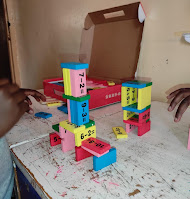The year 2020 brought with it a whirlwind of unforeseen
challenges, among them the sudden shift to homeschooling due to the pandemic.
As a parent, navigating this uncharted territory proved to be both daunting and
rewarding. With my kids at home and my own work responsibilities to attend to,
the task of striking a balance between work and ensuring my children's
education did not falter felt like a tightrope walk. However, amidst the
uncertainties, I discovered a treasure trove of innovative educational resources
that kept my kids engaged, curious, and excited about learning. In this
article, I share my homeschooling journey, reflecting on the challenges I faced
and the creative solutions we embraced to nurture our children's intellectual
growth. One particular gem in our educational arsenal was the Preschool
Mathematics Domino—a versatile tool that not only sharpened their mathematical
skills but also fostered problem-solving and critical thinking abilities.
The sudden shift to homeschooling was uncharted territory for our family. As the pandemic confined us to the four walls of our home, my kids' education was my top priority. Yet, I soon discovered that traditional pen and paper activities were met with dwindling interest and enthusiasm. The need for an alternative approach became evident, and I embarked on a quest to explore innovative educational resources that could capture their imagination and foster a love for learning.
In one of the most cherished activities, we coined it the
"domino wheel." Inspired by an image on the mathematics domino
storage box, the kids took on the challenge of replicating a circular structure
using the domino pieces. This task proved to be both fun and challenging,
enhancing their motor skills and problem-solving abilities. With each collapse
and rebuild, their determination to succeed and improve their design shone
through, resulting in moments filled with laughter and delight.
An additional activity they engaged in was designing a domino wheel; as we nicknamed it. They observed an image printed on the mathematics domino storage box and then mimicked it to achieve a circular structured design. This challenging task enhanced the kids’ motor skills every time they built it up after collapsing. It is an exciting and fun activity full of laughter.
To all fellow parents embarking on the homeschooling
adventure, I wholeheartedly encourage you to explore alternative educational
resources that ignite the spark of curiosity in your children. Embrace the
world of hands-on learning, where imagination knows no bounds, and creativity
takes flight. Let's create an environment where problem-solving and critical
thinking are celebrated, and each challenge is an opportunity for growth.
See a link to view the kids solving the sums:
Subtraction Addition





















